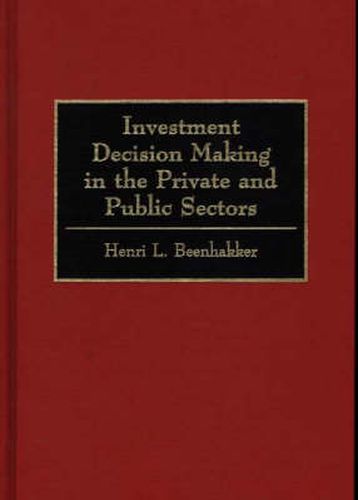Readings Newsletter
Become a Readings Member to make your shopping experience even easier.
Sign in or sign up for free!
You’re not far away from qualifying for FREE standard shipping within Australia
You’ve qualified for FREE standard shipping within Australia
The cart is loading…






The analysis of investment decisions today draws upon a wide range of sources, from economics and finance to engineering economy and operations research. Dr Beenhakker’s book reflects this interdisciplinary approach, and without assuming prior knowledge of these fields or a sophisticated understanding of mathematics, provides professionals and upper-level students with the concepts and tools they need to make enlightened investments in new ventures. Arranged to permit rapid review of an entire investment subject and written in a modular manner to allow readers to jump among chapters without losing their bearings, the book should help business managers deal intelligently with corporate financial and economic issues and government contracts. It should also help planners of the public sector incorporate the views of private industry in their own investment decision making. Dr Beenhakker begins wit a study of financial statements and ratios, and covers annual reports, balance sheets, income and retained earnings statements, cash flow statements, and financial ratios. In chapter 2 he looks at the valuation and investment problems when shares are under- or overvalued. He moves then to derivative securities, and in Chapter 4 to a discussion of diversification planning. In chapter 5 he takes up the costs of capital, with special attention to risk, uncertainty and in chapter 6 covers that and other topics in the context of project appraisal. Chapter 7 digs into programming and planning, and covers topics such as the marginal cost of capital in capital budgeting, the optimal capital budget, capital rationing, and economic development plans. The book ends with a discussion of cost minimization problems, such as leasing and purchasing, replacement investments, expansion investments, decision trees and the problem of how to ship quantities from supply to demand centres such that the total cost of transport is minimized. Five appendices provide readers with various tables and formulas to assist in their own calculations.
$9.00 standard shipping within Australia
FREE standard shipping within Australia for orders over $100.00
Express & International shipping calculated at checkout
Stock availability can be subject to change without notice. We recommend calling the shop or contacting our online team to check availability of low stock items. Please see our Shopping Online page for more details.
The analysis of investment decisions today draws upon a wide range of sources, from economics and finance to engineering economy and operations research. Dr Beenhakker’s book reflects this interdisciplinary approach, and without assuming prior knowledge of these fields or a sophisticated understanding of mathematics, provides professionals and upper-level students with the concepts and tools they need to make enlightened investments in new ventures. Arranged to permit rapid review of an entire investment subject and written in a modular manner to allow readers to jump among chapters without losing their bearings, the book should help business managers deal intelligently with corporate financial and economic issues and government contracts. It should also help planners of the public sector incorporate the views of private industry in their own investment decision making. Dr Beenhakker begins wit a study of financial statements and ratios, and covers annual reports, balance sheets, income and retained earnings statements, cash flow statements, and financial ratios. In chapter 2 he looks at the valuation and investment problems when shares are under- or overvalued. He moves then to derivative securities, and in Chapter 4 to a discussion of diversification planning. In chapter 5 he takes up the costs of capital, with special attention to risk, uncertainty and in chapter 6 covers that and other topics in the context of project appraisal. Chapter 7 digs into programming and planning, and covers topics such as the marginal cost of capital in capital budgeting, the optimal capital budget, capital rationing, and economic development plans. The book ends with a discussion of cost minimization problems, such as leasing and purchasing, replacement investments, expansion investments, decision trees and the problem of how to ship quantities from supply to demand centres such that the total cost of transport is minimized. Five appendices provide readers with various tables and formulas to assist in their own calculations.